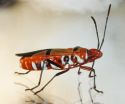(Press-News.org) The new study analyses data from school aged children in Tanzania infected with the most common forms of worms. It was found that infection by one parasitic species actually changes the risk of catching another, over and above other risk factors.
The study is the first to look at the significance of infection with one disease as a risk for further infections (i.e. co-infection). The findings could help us better understand the importance of co-infection as a risk, and could help inform disease control strategies.
Traditionally, co-infection, where the person or population of people has more than one parasite species in it, has been seen as a result of other risks. For example, if people in a population have two different parasites more often than expected by chance, then it is often thought that these two parasites must have been picked up at the same time because of where they are in the environment (co-exposure) and that the place the person lives or plays therefore is the cause of this co-infection (in other words a person's environment would be the risk factor).
Dr Joanne Lello, Cardiff University School of Biosciences and lead author on the study said: "Infectious diseases are among the most important causes of childhood mortality and morbidity in the developing world. Understanding what drives an individual's infections is essential if effective disease-control strategies are to be developed. We know there are many possible risk factors associated with an individual's infections, including their physical environment, genetics, behaviour and demographic factors, but a comparatively understudied risk factor for infection with one organism is co-infection with a second species."
By studying the associations between the four most prevalent infections among school-aged children in Tanzania - Ascaris lumbricoides, Trichuris trichiura, hookworm and self-reported fever - Dr Lello and colleagues (from the Universities of Bristol and Basel (Switzerland) and from the Ministry of Health in Tanzania), found that co-infection cannot be explained away as a simple coincidence that is due, for example by co-exposure in the environment.
They found that co-infection is itself a very important risk factor, and sometimes more important than any of the other risks considered, such as a child's living conditions, behaviour and sex. However, the risk does not always increase. They also find that infection with one parasite species can sometimes be associated with a lower risk of infection with a second parasite species.
Explaining the significance of these findings, Dr Lello, said: "We were able to include in our statistical model many different things which have been identified as risks before, for example a child's living conditions, behaviour, sex and so on. As such we could tell that the co-infections were not just caused by these 'other' risks and importantly we could also tell how much difference every risk made compared to one another. This showed us that co-infection was important for all the diseases we looked at and often it was more important than most of these 'other' risks.
"When medics and government design programmes to control diseases they use their knowledge of what things change the probability of becoming infected, called risk factors. If we miss out important risk factors then control programmes are unlikely to work effectively and resources can be wasted targeting the wrong things. Knowing that co-infection is a major risk factor is therefore really important and our study demonstrates this for the first time.
"Although our study was conducted on children in Tanzania, co-infection with different parasites occurs everywhere and so the principle that one parasite can change the probability of being infected with another has wide implications."
INFORMATION:
'The Relative contribution of co-infections to focal infection risk in children' is published in the Proceedings of the Royal Society B.
New study identifies significance of co-infection in disease control
2013-01-09
ELSE PRESS RELEASES FROM THIS DATE:
The Teotihuacans exhumed their dead and dignified them with make-up
2013-01-09
In collaboration with the National University of Mexico, a team of Spanish researchers has analysed for the first time remains of cosmetics in the graves of prehispanic civilisations on the American continent. In the case of the Teotihuacans, these cosmetics were used as part of the after-death ritual to honour their city's most important people.
A research team from the Polytechnic University of Valencia and the University of Valencia has studied various funerary samples found in urns in the Teotihuacan archaeological site (Mexico) that date from between 200 and 500 ...
R U eating healthy 2day?
2013-01-09
AUDIO:
Melanie Hingle, Ph.D., MPH, RD, University of Arizona, discusses the effectiveness of using text messaging to engage adolescents in ‘‘conversations’’ about health using a familiar communication method -- that is...
Click here for more information.
Philadelphia, PA, January 9, 2013 – According to the Nielsen consumer research group, teens receive an average of 3,417 text messages per month (that's 114 texts per day!). Couple this with CDC's report that high school students' ...
Making whole wheat bread taste and smell more appetizing
2013-01-09
The key to giving whole wheat bread a more appetizing aroma and taste may lie in controlling the amounts of a single chemical compound that appears in the bread, which nutritionists regard as more healthful than its refined white counterpart. That's the finding of a new study in ACS' Journal of Agricultural and Food Chemistry, which opens the door to making whole wheat bakery products more appealing to millions of people.
Devin G. Peterson and colleagues explain that whole wheat flour includes all three layers of the grain — bran, germ and endosperm — while refined flour ...
Chemical modules that mimic predator-prey and other behaviors
2013-01-09
Scientists are reporting development of chemical modules that can reproduce, on an "unprecedented" molecular level, changes and interactions that occur in natural populations of plants and animals, including those of hunting and being hunted for food, conducting mutually beneficial relationships and competing for resources. The report on these new "predator-prey biochemical oscillators," which could become building blocks for molecular machines and computers, appears in ACS Nano.
Yannick Rondelez and Teruo Fujii explain that just as plants and animals interact in complex ...
Bugs need symbiotic bacteria to exploit plant seeds
2013-01-09
This press release is available in German.
Aggregations of the red and black colored firebugs are ubiquitous under linden trees in Central Europe, where the bugs can reach astounding population densities. While these insects have no impact on humans, their African, Asian, and American relatives, the cotton stainers, are serious agricultural pests of cotton and other Malvaceous plants. Researchers at the Max Planck Institute for Chemical Ecology in Jena, Germany, recently discovered that these bugs need bacterial symbionts to survive on cotton seeds as their sole food source. ...
Used coffee grounds are a rich source of healthful antioxidants
2013-01-09
To plant food, insect repellant and other homespun uses for spent coffee grounds, scientists are adding an application that could make the gunk left over from brewing coffee a valuable resource for production of dietary supplements. Their new report in ACS' Journal of Agricultural and Food Chemistry concludes that used coffee grounds are a rich source of healthful antioxidant substances.
Maria-Paz de Peña and colleagues explain that people around the world drink millions of cups of coffee every day, generating about 20 million tons of used grounds annually. Although some ...
Expert suggests tried-and-true strategies to strengthen your relationship
2013-01-09
URBANA – What are you doing to keep your relationship alive? A University of Illinois study highlights the importance of five relationship maintenance strategies that couples can use to preserve or improve the quality of an intimate relationship.
"Relationships are like cars in that you have do certain things to keep them running, especially when your goal is to strengthen and preserve your bond with your partner," said Brian Ogolsky, a U of I professor of human and community development.
To determine which factors are the most important in promoting healthy relationships, ...
News from the world of quantum physics: A non-causal quantum eraser
2013-01-09
This press release is available in German.
Whether a quantum object behaves like a wave or like a particle depends (according to the Copenhagen interpretation) on the choice of measurement apparatus used for observing the system, and therefore on the type of measurement performed.
Anton Zeilinger's team of physicists at the University of Vienna and the Austrian Academy of Sciences has recently taken this phenomenon further than ever. Whether a certain photon behaves like a particle or like a wave depends on the measurement performed on a second photon. In the ...
Supply problems spark search for new ways to make magnets -- not the 'fridge' variety
2013-01-09
Mention magnets, and most people think of trivial applications of those pieces of metal, like holding family photos and reminder notes on the refrigerator. An article on magnets in the current edition of Chemical & Engineering News (C&EN), however, focuses on the critical role magnets play in the real world and the search for new materials to make them. C&EN is the weekly newsmagazine of the American Chemical Society, the world's largest scientific society.
In the article, C&EN Senior Correspondent Mitch Jacoby explains that magnets are crucial to an enormous number of ...
Why are children at higher risk for negative health effects of environmental toxins?
2013-01-09
New Rochelle, NY, January 9, 2013—More than 85,000 synthetic chemicals are registered for commercial use with the U.S. Environmental Protection Agency (EPA), and only about half of those produced in large quantities are tested for their potential toxic effects on humans. Children are particularly vulnerable to environmental toxins and a detailed look at how and why, and what can be done to protect children's health, is presented in a two-part article published in Alternative and Complementary Therapies from Mary Ann Liebert, Inc., publishers. The articles are available ...




